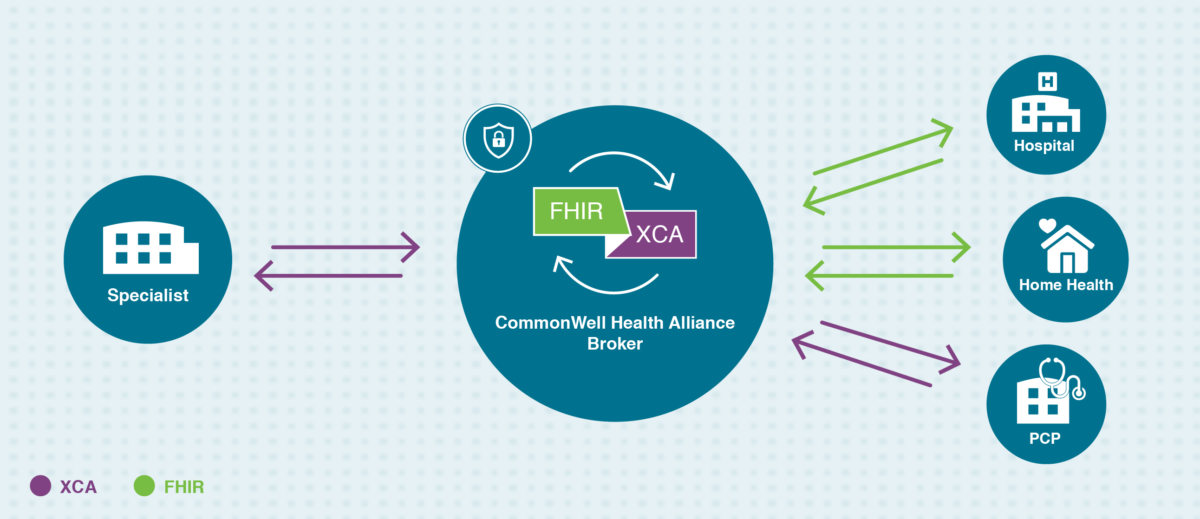CommonWell and FHIR go way back.
We embraced it from the beginning. We were the first network in production with the HL7 FHIR v.0.08 specification for patient identity management in 2014. And a year ago, we became the first network to put APIs into production that conform to the DSTU2 version.
But how did FHIR, Fast Healthcare Interoperability Resources, really take root in CommonWell? It’s through the Alliance culture.
A culture engineered for collaboration
On day one, not all CommonWell members wanted to use the old HL7 v2 PIX solution to provide registration messages to CommonWell. Some advanced members wanted to develop a future-facing solution including REST and FHIR. Also, the Alliance wanted to offer flexibility via multiple onboarding pathways for our members, so we collectively decided to support both methods -HL7 v2 PIX and HL7 FHIR. This flexible approach is a recurring theme across many of our services.
Brightree’s Gary Bartlett recently shared with me his observation at the Alliance’s level of transparency. “There aren’t any secrets,” he said. “CommonWell is a unique organization. The member companies — although in many cases competitors — come together and roll up their sleeves to work toward the mission.”
Collaboration that makes the architecture work. Without collaboration, the Alliance’s infrastructure would simply be another set of endpoints that didn’t actually contribute to data exchange across all care settings.
Alliance members are the ones who create change. Indeed, it has to be that way – CommonWell only has one employee.
We are heavily influenced by committee governance, and so we are driven by our members for the benefit of our members. The members have an ability to influence what gets created, how it gets created, and how it’s deployed.
Plus the “why” – improving healthcare for real patients – is never far from our minds.
How CommonWell uses FHIR
While culture enables the innovation, actual development still needs to take place. Let me take a deep dive into how exactly FHIR is being used with the CommonWell services.
- FHIR is used by CommonWell members to support person enrollment.
Messages (sent via the FHIR or IHE-PIX protocols) prepopulate CommonWell with demographic and encounter data from each connected system. - Once links have been created, connected systems can request a list of available remote patient content using either XCA or FHIR queries.
Change Healthcare, as the CommonWell services provider, has enabled the bridge between IHE XCA specifications and FHIR by converting requests and responses across the two standards in real time.These actions are brokered by the CommonWell infrastructure to simplify the work required by participating systems. To the requesting HIT product, these transactions appear to be no different than a standard query against any remote HIT system, although the responses are being aggregated from many responding systems. - CommonWell uses the flows defined by XCA to distribute or “fan out” ITI-38 queries to all known remote systems where content for the patient might be available.
Queries return aggregated metadata about all available clinical data to the requesting system where the requesting user can potentially select the data most valuable to them from a list, all within the familiar user interface of the local HIT system.When a user initiates a retrieval, files are escorted through the CommonWell network (but are not stored or cached there), and their contents are only accessible by the receiving system. The platform uses a layered security approach to help ensure the safety of the clinical and demographic data being transferred. - A combination of Public Key Infrastructure (PKI), JSON Web Tokens (JWT), and SAML 2.0 are used to authenticate and authorize a given edge system to the CommonWell services.
Only trusted systems are permitted to execute requests against the platform.Therefore, regardless of standard used, it is a seamless experience for the member company edge system. - Members have options
Offering FHIR as a standard to members developing the CommonWell services, enables our members to have options (including IHE standards – XCA, XDS.b, etc.) when building the CommonWell services into their technology. In fact, it gives our members an arguably faster more developer-friendly option for integrating with the CommonWell services.
Coming up, you’ll hear from two of our members – Brightree and MEDITECH – and why they have chosen to develop the CommonWell services using FHIR.
Hope you are FHIRed up to see FHIR in action at the Nationwide Care Transitions HIMSS Interoperability Showcase in March.
Andrew Wright, Sr. Product Manager, Change Healthcare and co-chair of the Use Case Committee.

